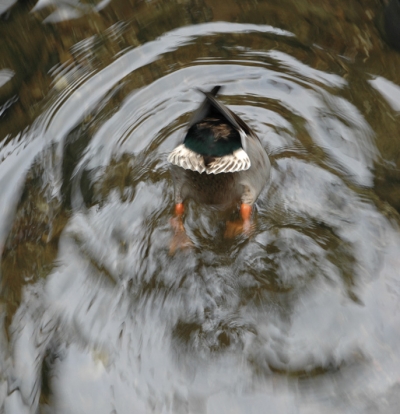Mallards in focus – and still under threat
There is an erratum that is worth mentioning – in regards to the shallow ponds being most used by broods. The shallow ponds are all less than 43cm deep. This is the depth that is recognised in literature as the maximum depth adult mallards can reach when tipping up to feed (Phillips 1923 & Olney 1960 in Perret 1962).
Additionally, staff have now completed sifting through the 250,000+ photos from our ‘Operation Duck Pond’ study. As anticipated, ponds in Southland that were used most often by broods had the following attributes:
- A greater area of shallow feeding zone, defined as pond depth being less than 43cm (the accepted maximum depth an adult duck will feed on the bottom). The majority of the top producing ponds were in fact, 100 percent shallow feeding zone. This resulted in many photos of feeding ducks, “heads down, bums up!”
- A higher availability of food items present (such as macroinvertebrates: waterboatmen, freshwater snails, etc). Obviously, there are many factors that affect the presence and abundance of these food items in a pond.
- A suitable level of shelter particularly from the south and west pond edges, and overhead cover present along the western edge.
- A fence to keep stock off the pond periphery so that vegetated edges were not grazed by livestock. Whether this is a relationship with stock disturbance, or degree of vegetation, we do not know.
- Creating shallow (or seasonal) ponds and wetlands that are protected from the elements will be a broods favourite retreat. These factors, coupled with successful predator control should see more ducklings (and mothers) survive the breeding season. However, that leads us to our next study.
This upcoming mallard breeding season the game cameras will be placed throughout the landscape aiming to capture images of mallard nest predators, namely stoats, ferrets and feral cats. This will be combined with a heavy trapping regime and monitoring of nests within a marked study area. We look forward to reporting on our results!
Perret, N.G. 1962. The spring and summer foods of the common mallard (Anas platyrhynchos platyrhynchos L.) in south central Manitoba. Unpubl. MSc Thesis, University of British Columbia, Vancouver.
And -Yeh – looks like the same cat, obviously included the pond in its circuit – have a dozen photos where you can just see the ears and head in the grass, where it obviously just sat and watched for ages! (Camera was set on time lapse, taking photos every 5 minutes).
Erin Garrick

